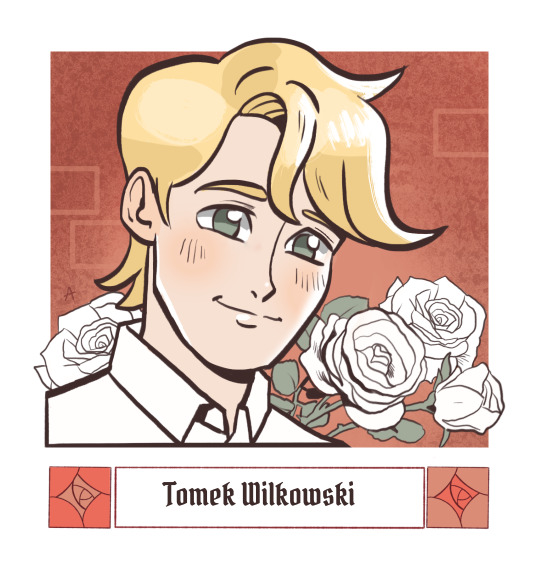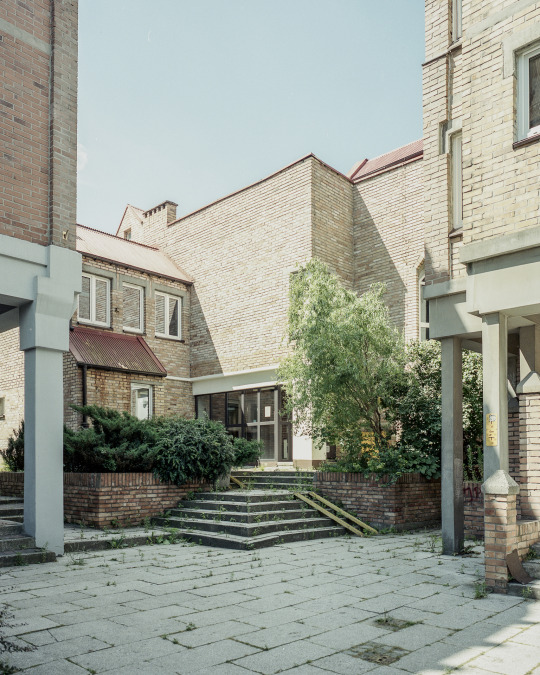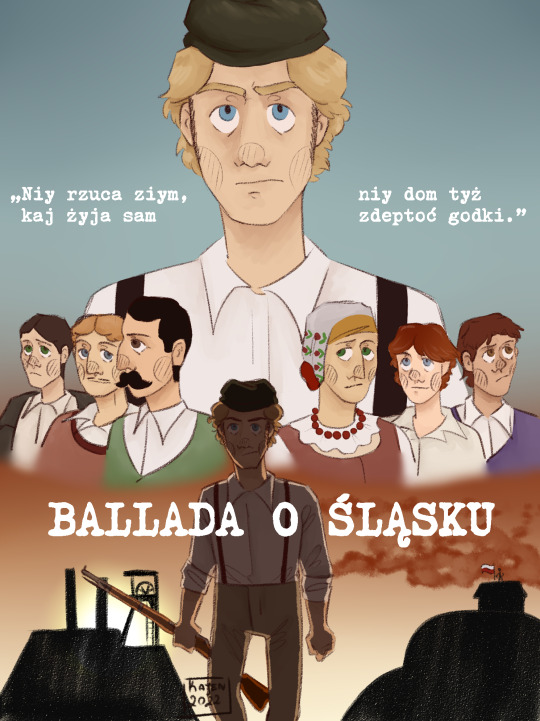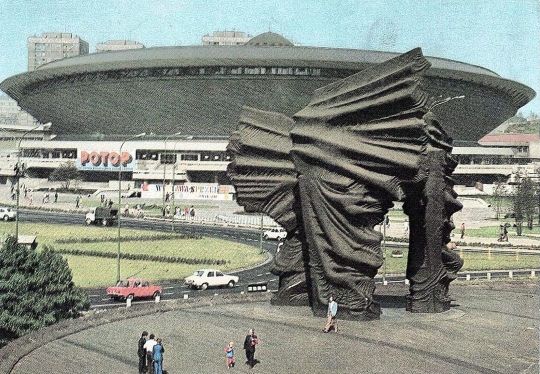#upper silesian
Text

Newest episode is on!
#zeflik szafranek#comics#zeflik#upper silesia#roses of nikiszowiec#silesian#nikiszowiec#art#illustration#oc
9 notes
·
View notes
Text

he stresses too much
tyn co sie durch nerwuje
ten, który się za dużo stresuje
#tomek wilkowski#tomek#oc#nikiszobietsunobara#nikiszowiec#comic#manga#upper silesia#silesia#silesian
13 notes
·
View notes
Text

The boys are going to the uprising!!
Hanik, Marcin, Ernst and Gynek.
#oc#original character#own character#oc art#oc artwork#oc tag#historical oc#history oc#hanik#gynek#ernst#marcin#1920s#20s#silesian uprisings#silesia#upper silesia#śląsk#górny śląsk#oberschlesien#poster#art#artwork#drawing#digital#my art#ballad about silesia#just their fighting clothes
11 notes
·
View notes
Photo






Insurgent fighters - almost all in posed pictures - from the Second Silesian Uprising / II powstanie śląskie, September 1920. Grabbed from sundry Polish news websites.
#second silesian uprising#ii powstanie śląskie#powstania śląskie#upper silesia#silesia#polish nationalism#polish uprising#history of poland#weimarer republik#weimar germany#insurgency
6 notes
·
View notes
Text
The word “Slavs” in the Slavic languages
Old Church Slavonic: Словѣне (Slověne)
Ukrainian: Слов’яни (Slovjany)
Slovak: Slovania
Czech: Slované
Polish: Słowianie
Kashubian: Słowiónie
Silesian, Lower Sorbian: Słowjany
Upper Sorbian: Słowjenjo
Slovene: Slovani
Serbian, Macedonian: Словени (Sloveni)
Montenegrin: Словјени (Slovjeni)
In these languages the pronunciation of the root has shifted from /o/ to /a/:
Russian, Belarusian, Rusyn: Славяне (Slavjane)
Bulgarian: Славяни (Slavjani)
Croatian, Bosnian: Slaveni
#slavs#slavic#ukrainian#slovak#czech#polish#kashubian#silesian#sorbian#slovene#serbian#macedonian#montenegrin#russian#belarusian#rusyn#bulgarian#croatian#bosnian
171 notes
·
View notes
Text

Kaiser Wilhelm Memorial Church, Berlin, Germany: The Kaiser Wilhelm Memorial Church, mostly just known as the Memorial Church is a Protestant church affiliated with the Evangelical Church in Berlin, Brandenburg and Silesian Upper Lusatia, a regional body of the Protestant Church in Germany. Wikipedia
46 notes
·
View notes
Photo

Piotr Tadeusz Potworowski (Poland 1898-1962)
Duet (1949) oil on canvas
Upper Silesian Museum. Poland
47 notes
·
View notes
Text

"Nad Jamną" estate, Mikołów, 2023
The estate of 12 residential buildings, built in 1983–1986 according to the design by Stanisław Niemczyk, is one of the lesser known examples of Polish postmodern architecture. Created in the era of shortages in the housing economy and the end of large projects of prefabricated blocks of flats, the estate in Mikołów - part of the Upper Silesian conurbation - is most often associated with classical Hanseatic architecture reinterpreted in a contemporary way.
#analog#mamiya 7#mamiya#medium format#120 film#kodak portra 400#deadpan#new topographics#postmodern#postmodernism#architecture
6 notes
·
View notes
Photo

“ Das Reitergefecht bei Liebertwolkwitz am 14. Oktober 1813.
Im Vordergrund Marschall Murat” by Richard Knötel
The cavalry battle at Liebertwolkwitz on October 14, 1813, in the foreground Marshal Murat
Crude google translation from the website linked below:
Duel with the King (Murat)
In the run-up to the Battle of Leipzig, on October 14, 1813, there was a cavalry battle between the cavalry corps of the Russian General Count von der Pahlen and the cavalry of the French Marshal and King of Naples, Murat. Since the battle, which lasted from 9 a.m. to 6 p.m., involved up to 15,000 horsemen from both sides in the melee, the battle is often called the "biggest cavalry battle of modern times".The Pahlen Cavalry Corps also included the Prussian Mounted Grenadier Regiment "Freiherr von Derfflinger" (Neumarkisches) No. 3, founded in 1807 in Bromberg. In association with two Russian hussar regiments, it encountered the French positions south of Leipzig in the course of a violent reconnaissance. In the wide plain between Dölitz, Markkleeberg, Wachau, Liebertwolkwitz and Holzhausen, Marshal Murat had his French, Poles and Rheinbündische entrenched in accordance with a plan by Marshal Victor.
Pahlen, who was only a moderately talented general, did not recognize this locking position and ordered the attack from the movement. The Allies quickly came under heavy French artillery fire from the Galgenberg, the dominant height in this flat country. The order "Collect backwards" had to be given while the French cavalry counterattacked. As always, Marshal Murat himself rode at the head in his theatrical costume.
Lieutenant Guido von der Lippe commanded the flanking platoon in the 2nd Squadron of Mounted Grenadiers. The young Upper Silesian made the decision to capture this "vain peacock". He used the moment, when the King of Naples was only accompanied by his body boy ( Leibbursche ), to make an unauthorized advance, accompanied by a few comrades from his cavalcade.
With the call "Halt, König, halt!", spoken in German, the lieutenant tried to grasp the reins of Murat's white palfrey. He dodged it skillfully and stared blankly at the young officer, drawn saber in hand. The body boy, on the other hand, reacted with lightning speed and knocked the attacker out of the saddle with his edged weapon. However, the approaching body squadron of the king put an end to the bold attempt at capture by the Neumärker.
Lieutenant Guido von der Lippe was found by his lad on the battlefield on October 16, 1813, hidden under corpses, and buried with honor by the 2nd squadron. The history painter Richard Knötel later created a lasting monument to him.
Murat's body boy was appointed "Royal Equerry", an "honorary pension from the city of Naples" for life and the horse of the lieutenant von der Lippe. Emperor Napoleon awarded the equerry the "Cross of the Legion of Honour".
Source: "The book of facts of the German cavalry." Dedicated to the German cavalry by Emil Buxbaum, Major on the staff of the kb 2nd Heavy Cavalry Regiment "Archduke Franz Ferdinand von Austria-Este", Berlin and Leipzig, Verlag Friedrich Luckhardt, 1900.
Link
23 notes
·
View notes
Text
Reminder that next episode will be on March 12th 2024
#upper silesia#roses of nikiszowiec#comics#zeflik#nikiszowiec#zeflik szafranek#art#illustration#silesian#oc#poland#germany#prussia
7 notes
·
View notes
Text

she is bad at drawing
tej co niy idzie kryklanie
ta co nie potrafi rysować za dobrze
#nikiszobietsunobara#nikishobietsu no bara#roses of nikiszowiec#rouzy nikiszowca#upper silesia#silesia#zeflik#manga#comic#stazyjka#stazyjka sznita#silesian manga#silesian language
7 notes
·
View notes
Text

Today (May 3rd) is the 101st anniversary of the Third Silesian Uprising, so I decided to make a poster for my story's 1st arc, which features those events.
#oc#original character#own character#oc art#oc artwork#oc tag#historical oc#history oc#hanik#gynek#ernst#marcin#lynka#gustlik#emil#1920s#20s#silesian uprisings#silesia#upper silesia#śląsk#górny śląsk#oberschlesien#poster#art#artwork#drawing#digital#my art#ballad about silesia
8 notes
·
View notes
Photo

Katowice, Upper Silesia, Poland: The Silesian Insurgents' Monument (1967) and "Spodek" arena complex (1971).#socmod Photo from 1973. https://www.instagram.com/p/CgeVbmsM8bL/?igshid=NGJjMDIxMWI=
2 notes
·
View notes
Text
Shoppers at two stores in the Kaufland supermarket chain in Silesia in southwestern Poland can now look for items in the local ethnolect as well as Polish – “Sery żółte” (hard cheeses) become “Kyjzy”, and “Musztardy” (mustards) are “Zymfty”.
The bilingual signs in Polish and Silesian indicating what items can be found on the shops’ aisles have been prepared by Adrian Goretzki, who runs the Po Naszymu (In our language) Silesian language office. He has been promoting the use of Silesian for many years and lobbying for it to be given the status of a regional language.
4 notes
·
View notes
Note
How’s summer in Upper Silesia?
It's beautiful in my corner of the region, with vast forests planted by Cistercian monks in the late medieval period, lakes and meadows between them. Back in the day, I even had the option to rent a horse for an hour or two and make an excursion like a proper gentleman of ye olde. Just like I wrote two years ago in that one post, wandering in the Upper Silesian countryside makes you absolutely ready to kill and die for this land and its people. Too bad the family that owned the horse farm sold it years ago and moved to Germany. Oh well.
High temperatures aren't so bad when you have a big house in the middle of a bona fide village and your own forest right behind said house. And then, the walls are thick enough to make your living comfortable even without A/C.
Too bad that the last time I visited home was two weeks ago and currently I'm stuck in the middle of a glorified shtetl.
5 notes
·
View notes
Photo

Piotr Potworowski (Poland 1898-1962)
Duet (1949)
oil on canvas
Upper Silesian Museum. Poland
29 notes
·
View notes